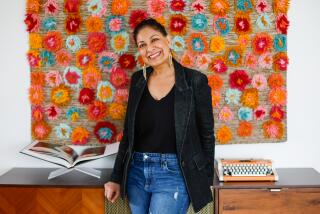the Battle of the Sexes, Continued: Commniques From the Trenches : Poet Examines ‘Mern and Women Now’ Through Looking Glass of Stories, Songs and Verse; Psychologist Uses the fabele of porcupine and Moles to Illustrate Gender Differences
By way of illustrating her point--that care-focused morality is primarily a female phenomenon while the traditional male definition of morality is justice-focused--Carol Gilligan was retelling Aesop’s fable of The Porcupine and the Moles:
Seeking refuge from the cold, a porcupine asked to share a desirable cave for the winter with a family of moles. The moles agreed but, theirs being a small cave, they soon found that they were being scratched each time the quilled porcupine moved about. Finally, they asked the porcupine to leave but the porcupine stood his ground, saying, “If you moles are not satisfied, I suggest that you leave.” The poor moles, burdened with a permanent guest, had learned their lesson: “It is well to know one’s guest before offering him hospitality.”
Asked for Solutions
Now, said Gilligan, researchers presenting the dilemma of the moles and the porcupine to a study group of 11-to-15-year-old suburban American children and asking for their solutions found the boys opting for justice--”It’s the moles’ house. It’s a deal. The porcupine leaves”--while the girls looked for solutions that would keep all parties content and comfortable, such as “Cover the porcupine with a blanket.”
Gilligan is not here to say that one gender is superior in its thinking, just that there are differences, long ignored in the psychological literature, in people’s ways of thinking about relationships, ways that she refers to as “male and female voices.”
And, while these differences are not strictly biological, she believes, it is clear that they “arise in a social context where factors of social status and power combine with reproductive biology to shape the experience of males and females and the relations between the sexes.”
Gilligan, a psychologist and associate professor of education at the Harvard University Graduate School of Education, has spent more than a dozen years exploring these differences, which she delineated in her acclaimed 1982 book, “In a Different Voice” (Harvard University Press).
Her work has won for her academic honors, honorary degrees and, in January, 1984, Ms. magazine’s cover as its “Ms. Woman of the Year.” In singling her out as a leader of the future, Ms. proclaimed: “Gilligan’s work has implications for a rather different kind of future--one in which humanity takes its cues not from Big Brother, but from sisters, mothers and daughters.” In retrospect, Gilligan said during a visit last week to Claremont, where she participated in a three-day symposium sponsored by the Claremont Colleges, the Ms. honor was a mixed blessing. “I live a very private life,” she explained. “I guess I thought I could send my work in without myself.”
After the magazine came out, she said, she received considerable criticism from some feminists who felt she was giving aid and comfort to the enemy. But, said Gilligan, “My work has always been criticized by certain groups of feminists who thought to talk about differences was to invite oppression.”
There was a turn-away audience for Gilligan’s talk at the Garrison Theater of the Claremont Colleges. Many were women, who related instantly to her recounting “one of the more illuminating moments in my research”--a woman, given a moral problem to resolve, had asked, “Do you want to know what I think or do you want to know what I really think?”
The implication, Gilligan said, was that she had “learned to think” in a way different from how she “really thought.”
Historically, she said, there has been the implication that there is a single standard of morality, defined as the moral perspective-- and it is the male perspective, measured against which women’s moral development has been found wanting.
Origins of Morality Traced
She traced the origins of morality to early childhood relationships and the two factors that shape this development: inequality, “reflected in the child’s awareness of being smaller and less capable,” and attachment to others.
In early childhood, she said, “the experience of attachment lessens the experience of inequality by empowering the child in relation to the parent who otherwise seems unmoveable and all-powerful. Perhaps because girls generally identify with their mothers . . . the experience of inequality seems less overwhelming in female development and the experience of attachment more salient. Women may pay less attention to the consequences of unequal relationships, especially when norms of feminine behavior impede striving toward equality.”
On the other hand, Gilligan said, “If boys identify with their fathers and are not closely attached to them, concerns about equality and justice become more salient, and separation or independence more necessary to self-esteem.” When their childhood feelings of inequality are compounded in adolescence by social inequality and by norms of male dominance, she said, “feelings of helplessness and powerlessness become heightened and the potential for violence increases.”
Children experience “genuine moral dilemmas,” she said, from “conflicts that arise when the demands of attachment and the demands of equality clash.” By way of illustration, Gilligan spoke of the quandary of the schoolchild who is uncertain whether to obey the rules or to help a friend on a test.
Gilligan said she has observed a tendency for girls to see attachment where boys saw inequality and thus to present care solutions as feasible “where boys saw them as naive and unworkable.”
Key to her analysis of the role of feelings in moral development, she said, is the observation in Milan Kundera’s novel, “The Unbearable Lightness of Being,” that all languages that derive from the Latin form the word “compassion” by combining the prefix meaning “with” and the root meaning “suffering.” In other languages, the similar prefix combines in the word with a root meaning “feeling.”
The significance of the latter, Gilligan said, is that “it changes the meaning of compassion from sympathy to love by changing the relationship implied from one of inequality to one of attachment,” lifts it out of the category of “second-rate sentiment.” To love someone out of compassion, she said, “means not really to love.”
When compassion is construed as co-feeling (“with feeling,” as in German and Swedish), Gilligan said, its moral qualities become clear--”Through co-feeling self and other become not equal or unequal but interdependent.”
When this happens, she said, the morality question is no longer one of how to live with inequality but one of how to live in connection with oneself and with others, “how to avoid detachment, the temptation to turn away from need.”
Psychologists have found, Gilligan said, that boys and girls identify equally well the feelings of others but girls tend to experience these feelings and from an early age practice sharing feelings while boys are more likely to focus on actions and plans.
Search for Equality
Her interest, she said is in the “tension” between the child’s search for equality--the effort to become stronger and more competent, like the adult--and the child’s need for the attachment that leads to feelings of empowerment.
“The implication that detachment (breaking away from the adult figure) constitutes a solution,” Gilligan said, “is, in my view, the major blind spot in current theories of self and moral development.
“The resistance of girls to detachment in adolescence has generally been interpreted as a failure of separation and as occurring at the expense of their intellectual and moral development . . . it seems instead to contain a different moral insight” with widespread implications.
“Perhaps,” she said, “the relational experience of little girls, not only their identification with their mothers but also their friendships throughout childhood, mitigate against detachment and its attendant egocentrism, keeping both their relational nature and their moral knowledge intact.”
(Gilligan has theorized that men seek autonomy and are threatened by intimacy, while women seek connectedness and are threated by isolation).
“Men and women may have a tendency to see from different standpoints or, put differently, to lose sight of different perspectives,” said Gilligan. “While it is true that either we are men or we are women and certain experiences may accrue more readily to one or the other sex, it is also true that the capacity for love and the appreciation of justice is not limited to either sex.”
Margo Haskins-Willey, a graduate student in psychology, arriving at a reception for Gilligan at the home of Mary Poplin, associate professor of education at Claremont Graduate School, extended her hand to Gilligan, and confessed, “I had this tension between picking up my children and coming here.”
The reception quickly evolved into a group discussion, with Gilligan, seated on a sofa, the guests, men and women, forming a conversation circle on the living room floor.
The discussion ranged from the conflicts of “supermoms” who, Gilligan observed, just might be saying, if anyone were to ask them, that they’d “rather be hanging out with their kids than going jogging” to the concept of androgyny.
She has trouble with androgyny, Gilligan said, because it “implies that there are two single qualities associated with males and females and now everyone can have it all. It really suggests that there’s as easy solution.”
Gilligan told of her personal and professional journey--from English major at Swarthmore College to psychologist and professor at Harvard. Always intrigued by “conflicts and turning points in people’s lives,” she said, “I did think I wanted to be a therapist . . . the one thing I was sure of when I was an undergraduate was I was not going to teach in university.”
By the early 70s, she said, “I have three sons, a husband, a male dog and a male cat . . . and I’m teaching at Harvard,” beginning to hear expressed by students the conflict of women and morality. By 1975, she realized “if I was not going to address the issue of how to speak as a woman in a male context I was going to have trouble at home and trouble at Harvard.”
Up to that point, said Gilligan, she had been teaching theory “as though everything I knew about human development from my own experience couldn’t possibly be relevant.”
She had her audience. The raspberry whipped cream tarts sat on their tray. The wine bar was deserted. With gentle humor, she had chided the graduate students in the group to finish their theses. With reflection and insight, she had addressed the challenges of being a woman in contemporary society.
Then a well-meaning organizer broke up the circle, suggesting that everyone might want to mingle.
Shrugged one young man, “Now it’s just a cocktail party.”
More to Read
The biggest entertainment stories
Get our big stories about Hollywood, film, television, music, arts, culture and more right in your inbox as soon as they publish.
You may occasionally receive promotional content from the Los Angeles Times.










